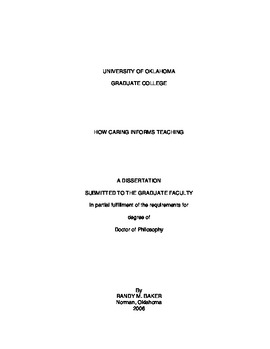| dc.contributor.advisor | Angelotti, Michael, | en_US |
| dc.contributor.author | Baker, Randy M. | en_US |
| dc.date.accessioned | 2013-08-16T12:20:27Z | |
| dc.date.available | 2013-08-16T12:20:27Z | |
| dc.date.issued | 2006 | en_US |
| dc.identifier.uri | https://hdl.handle.net/11244/1122 | |
| dc.description.abstract | This study is a qualitative investigation into the concept of care based on a heuristic research design constructed by Clark Moustakas. The researcher relied on the belief that teachers are knowers through lived experience and can rely on their own "personal practical knowledge" to understand better the classroom and the world around them. Since I have been a classroom teacher for the past 32 years, I explored the phenomenon of caring and its true and deeper meaning in an attempt to illuminate basic structures and essences through memories and personal narratives. Based on Michael Polanyi's concept that human beings know things implicitly or unconsciously through tacit knowledge, I began this study prompted by a serendipitous encounter with a special student. This led me to want to know more about how to care for my students, but first I wanted to know explore more fully this concept of care. From this initial encounter I was able to develop my research question. | en_US |
| dc.description.abstract | My heuristic research design fit perfectly into my desire to understand care through the relationships and experiences of my private and public life. Through my personal journaling, I reflected upon those administrators, teachers, and students who I will never forget for one reason or another. As I began to immerse myself deeply into the caring relationships with those students, memories with family and friends also began to surface. Finally, I realized that these memories would provide the rich data that I needed to study care. Once the data had been collected, I had separated the data according to essential themes. I tried to distance myself from the study for a while only to return with a deeper sense of purpose and commitment to the study. Finally, I interviewed the teaching faculty at my school as well as students to broaden my sense of perspective, to reaffirm my own insights, and to provide additional and alternative ways of thinking. | en_US |
| dc.description.abstract | In my conclusion, I offer my insights about care and its importance in the classroom, schools, and world today. I also show a few ways in which I implement care in my classroom from simple teaching techniques to class projects. Finally, I recommend further study that is important if we are to transform education and if we really do care about our children. | en_US |
| dc.format.extent | x, 314 leaves ; | en_US |
| dc.subject | Teacher-student relationships Case studies. | en_US |
| dc.subject | Teachers Social networks Case studies. | en_US |
| dc.subject | Education, Teacher Training. | en_US |
| dc.subject | Education, Curriculum and Instruction. | en_US |
| dc.title | How caring informs teaching. | en_US |
| dc.type | Thesis | en_US |
| dc.thesis.degree | Ph.D. | en_US |
| dc.thesis.degreeDiscipline | Department of Instructional Leadership and Academic Curriculum | en_US |
| dc.note | Adviser: Michael Angelotti. | en_US |
| dc.note | Source: Dissertation Abstracts International, Volume: 67-10, Section: A, page: 3691. | en_US |
| ou.identifier | (UMI)AAI3239544 | en_US |
| ou.group | Jeannine Rainbolt College of Education::Department of Instructional Leadership and Academic Curriculum | |
